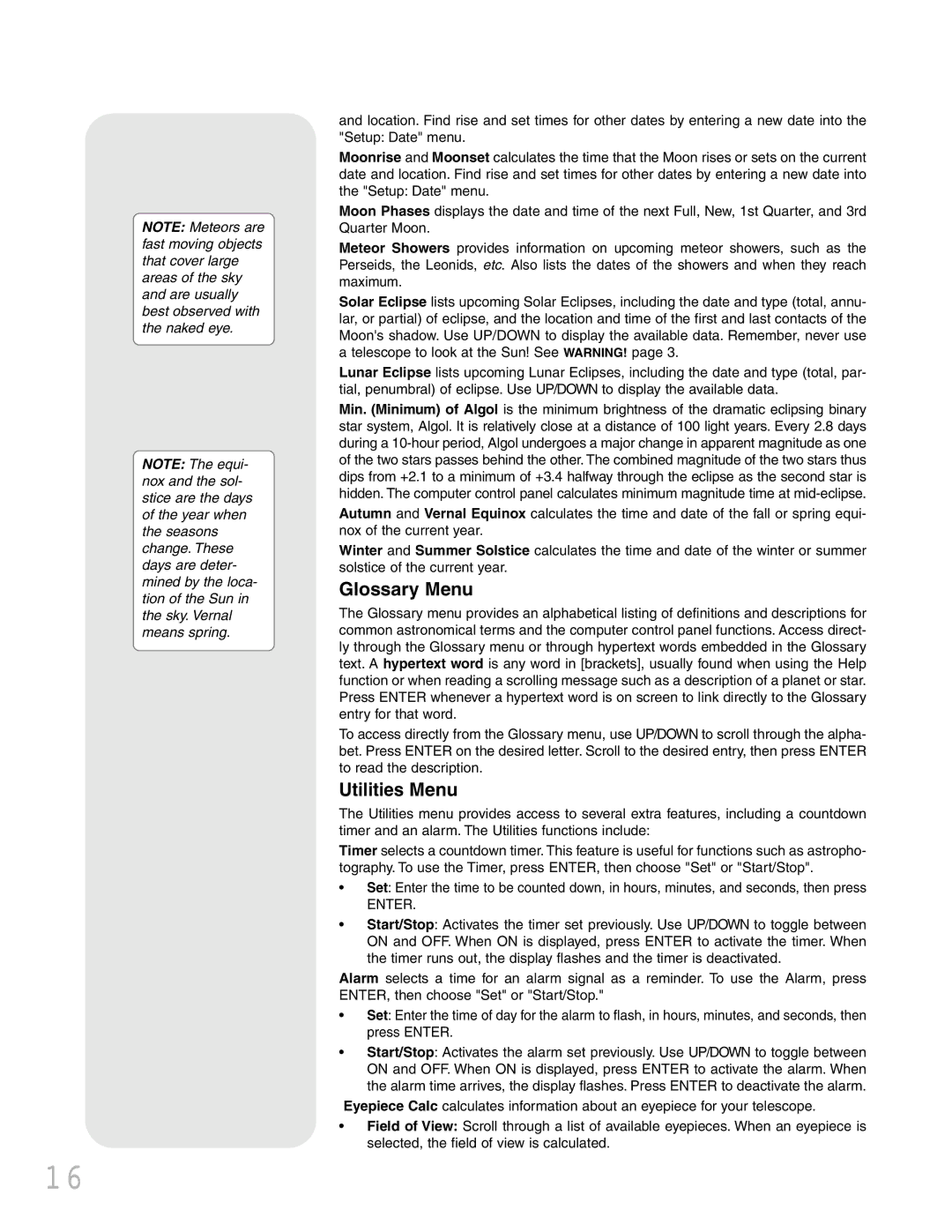
NOTE: Meteors are fast moving objects that cover large areas of the sky and are usually best observed with the naked eye.
NOTE: The equi- nox and the sol- stice are the days of the year when the seasons change. These days are deter- mined by the loca- tion of the Sun in the sky. Vernal means spring.
and location. Find rise and set times for other dates by entering a new date into the "Setup: Date" menu.
Moonrise and Moonset calculates the time that the Moon rises or sets on the current date and location. Find rise and set times for other dates by entering a new date into the "Setup: Date" menu.
Moon Phases displays the date and time of the next Full, New, 1st Quarter, and 3rd Quarter Moon.
Meteor Showers provides information on upcoming meteor showers, such as the Perseids, the Leonids, etc. Also lists the dates of the showers and when they reach maximum.
Solar Eclipse lists upcoming Solar Eclipses, including the date and type (total, annu- lar, or partial) of eclipse, and the location and time of the first and last contacts of the Moon's shadow. Use UP/DOWN to display the available data. Remember, never use a telescope to look at the Sun! See WARNING! page 3.
Lunar Eclipse lists upcoming Lunar Eclipses, including the date and type (total, par- tial, penumbral) of eclipse. Use UP/DOWN to display the available data.
Min. (Minimum) of Algol is the minimum brightness of the dramatic eclipsing binary star system, Algol. It is relatively close at a distance of 100 light years. Every 2.8 days during a
Autumn and Vernal Equinox calculates the time and date of the fall or spring equi- nox of the current year.
Winter and Summer Solstice calculates the time and date of the winter or summer solstice of the current year.
Glossary Menu
The Glossary menu provides an alphabetical listing of definitions and descriptions for common astronomical terms and the computer control panel functions. Access direct- ly through the Glossary menu or through hypertext words embedded in the Glossary text. A hypertext word is any word in [brackets], usually found when using the Help function or when reading a scrolling message such as a description of a planet or star. Press ENTER whenever a hypertext word is on screen to link directly to the Glossary entry for that word.
To access directly from the Glossary menu, use UP/DOWN to scroll through the alpha- bet. Press ENTER on the desired letter. Scroll to the desired entry, then press ENTER to read the description.
Utilities Menu
The Utilities menu provides access to several extra features, including a countdown timer and an alarm. The Utilities functions include:
Timer selects a countdown timer. This feature is useful for functions such as astropho- tography. To use the Timer, press ENTER, then choose "Set" or "Start/Stop".
•Set: Enter the time to be counted down, in hours, minutes, and seconds, then press
ENTER.
•Start/Stop: Activates the timer set previously. Use UP/DOWN to toggle between ON and OFF. When ON is displayed, press ENTER to activate the timer. When the timer runs out, the display flashes and the timer is deactivated.
Alarm selects a time for an alarm signal as a reminder. To use the Alarm, press ENTER, then choose "Set" or "Start/Stop."
•Set: Enter the time of day for the alarm to flash, in hours, minutes, and seconds, then press ENTER.
•Start/Stop: Activates the alarm set previously. Use UP/DOWN to toggle between ON and OFF. When ON is displayed, press ENTER to activate the alarm. When the alarm time arrives, the display flashes. Press ENTER to deactivate the alarm.
Eyepiece Calc calculates information about an eyepiece for your telescope.
•Field of View: Scroll through a list of available eyepieces. When an eyepiece is selected, the field of view is calculated.
16
